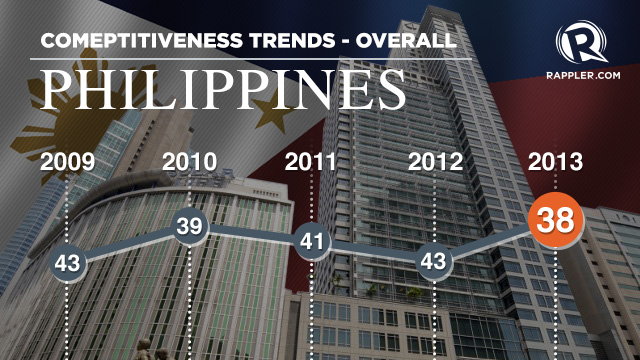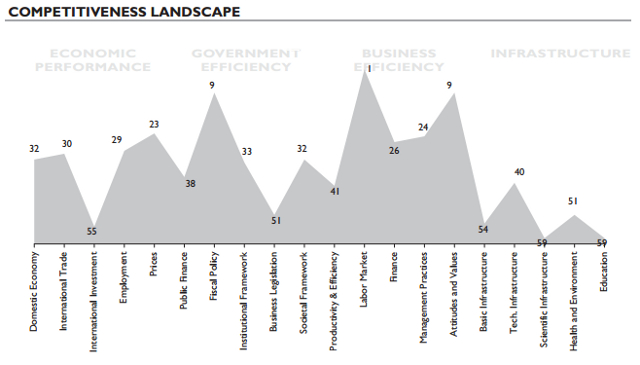
The Philippines was one of the most improved countries in the region in the 2013 World Competitiveness Yearbook (WCY) ranking.
The country improved 5 notches to 38th out of 60 countries worldwide on the back of strong macroeconomic fundamentals and upbeat investor confidence. In 2012, the country ranked 43rd out of 59 countries.
Among its peers in the Asia-Pacific, the Philippines, with its score of 63.146, bested Indonesia and India which ranked 39th and 40th, overall.
Data showed that this is the best performance of the Philippines since 2009. The country's latest ranking beat the 39th overall rank it posted in 2010.
"The country has reversed two consecutive years of decline and it is now 11th among Asia-Pacific countries in the sample (compared to 13th in 2009). The Philippines has now overtaken both India and Indonesia in the sample of Asia-Pacific countries of the WCY," Institute for Management Development (IMD) said in a report.
"Backed by a robust 6.6% GDP growth – the second highest in Asia – a soaring stock market, and an upgrade to investment grade by two major rating agencies, the Philippines has been hailed by many analysts as the next economic tiger of Asia," it added.
Key factors
The WCY measures 4 broad factors in measuring competitiveness—economic performance, government efficiency, business efficiency and infrastructure.
The survey results showed that the Philippines' rank in economic performance improved 11 places to 31st in 2013 from 42nd in 2012. This is the second best ranking that the country posted in economic performance after placing 29th overall in 2011.
Among the sub-factors, the Philippines ranked highest in terms of prices at 23rd, a decline from 17th in 2012. The country's lowest rank in this category is international investment ranking, which decelerated to 55th in 2013 from 54th in 2012.
"This is backed by the 6.6% real GDP growth in 2012, the second highest in WCY, controlled inflation of 3.2%, and an 8.8% increase in exports of goods and services (in pesos)," IMD said.
In terms of government efficiency, IMD data showed it hardly moved but improved from 32nd to 31st. This is the same rank it posted in 2010.
Although total tax revenues increased by 13.2%, the country's budget deficit increased to P242.8 billion in 2012 from P197.8 billion in 2011. IMD also said the country's debt-to-GDP ratio of 51.4% in 2012 is slightly higher than the 50.9% in 2011.
Among the sub-factors, the highest ranking was in fiscal policy, which was 9th overall, an improvement from 11th place in 2012. Business legislation, on the other hand, continued to trail other sub-factors and was ranked 51st overall, a slowdown from 49th place in 2012.
Further, business efficiency improved 7 places from 26th to 19th, mostly because of the soaring stock market. This is the first time since 2009 that the country's business efficiency ranking was above 20th place.
Among the sub-factors, labor market continued to be ranked 1st overall, maintaining its position in 2012. In this factor, productivity and efficiency ranked the lowest at 41st but was an improvement of 14 notches from 55th place in 2012.
"This is mostly pulled by the 5.4% growth (fourth in this year’s WCY) in overall productivity (real GDP per person employed), as GDP grew robustly while employment growth languished. However, it is noticeable that although the Philippines ranked high in growth of overall productivity, the country is ranked 59th in level of overall productivity," IMD said.
Despite efforts of the government to address the country's infrastructure constraints, infrastructure was the only factor that posted a decelation to 57th place in 2013 from 55th in 2012.
IMD data showed this is the same ranking Philippine infrastructure got in 2011, the lowest ranking it got since 2009. Data showed that this is because 4 out of the 5 sub-factors were ranked below 50.
Technological Infrastructure ranked the highest at 40th, an improvement of 6 notches from 46th in 2012. Tied for lowest place are Education and Scientific Infrastructure at 59th overall, a deceleration from 57th and 58th place, respectively.
"Poor infrastructure is a hindrance not only to more efficient domestic economic activity, but also in more successfully attracting foreign investments. The country’s ASEAN neighbors Malaysia, Thailand and Indonesia, are ranked 25th, 48th, and 56th, respectively, in infrastructure. It is not surprising that these countries also perform much better in attracting foreign investments," IMD said.
Inequality persists
Despite the glowing economic performance of the Philippine economy in 2012, IMD said it is important for the country to exert more effort in attaining inclusive growth.
IMD found it disappointing tha,t while the country did register above 6% growth in 2012, the National Statistical Coordination Board (NSCB) data showed poverty incidence hadly moved in the first semester of 2012.
The country's poverty incidence stood at 27.9% in the first semester of 2012, virtually unchanged from the same period in 2006 and 2009.
Poverty incidence in the same period in 2009 was 28.6% and in 2006, 28.8%, National Statistical Coordination Board (NSCB) Secretary General Jose Ramon Albert said in a press conference last April 23.
Data showed that most of the poorest provinces are located in Mindanao while the least poor were located mainly in Luzon. IMD said this mirrors 2011 data that showed the National Capital Region accounted for 36% of GDP but only 13% of population while Mindanao contributed only 14% but has 24% of population.
INTERACTIVE: The poorest provinces in the Philippines
"The result was disappointing, to say the least, as poverty incidence hardly moved from the 2009 level, in spite of six percent average annual GDP growth during these years. Regional GDP figures show the imbalance of growth and development in the country," IMD said.
IMD added that NCR's per capita GDP was almost 13 times greater than ARMM. This may not be a surprise considering that investments in infrastructure favored Luzon.
It noted that majority of the PPP projects rolled out in 2011 and in 2012 are in Luzon, with a small share going to Visayas, and none in Mindanao.
There are also imbalances in employment. IMD said 40% of workers in the Philippines are "vulnerable" or unpaid family workers and own-account workers.
IMD said occupations with the highest wage such as government, private enterprises, and organization officials are paid more than 4 times the lowest-paid occupation - laborers and unskilled workers.
"Wages are also highly uneven – average wage in NCR (the region with the highest wage) is almost twice that in the lowest wage region (Region IX)," IMD said.
"Wages in the highest-paid sector (extra-territorial organizations and bodies) are almost 7 times higher than in the lowest-paid sector (private households with employed persons)," it added.
Challenges in 2013
IMD said the following are the main challenges of the Philippines in 2013:
Infrastructure - many roads remain unpaved and the main airport is operating beyond capacity
Corruption - ranked 105th out of 174 by Transparency International
Unemployment - is amongst the highest of the ASEAN5 group
Undeveloped financial system and access to finance - access to finance is one of the greatest challenges facing SMEs
Natural disasters - on average 20 typhoons visit annually, causing billions of pesos in damages
Since 1997, the AIM Policy Center has been a partner institute of the International Institute for Management Development (IMD) for the annual release of the WCY.
It draws on hard economic data from various international and national sources, as well as the executive opinion survey of top and middle managers from the ranked countries. The study analyzes over 300 competitiveness criteria to assess and rank the nations. - Rappler






No comments:
Post a Comment